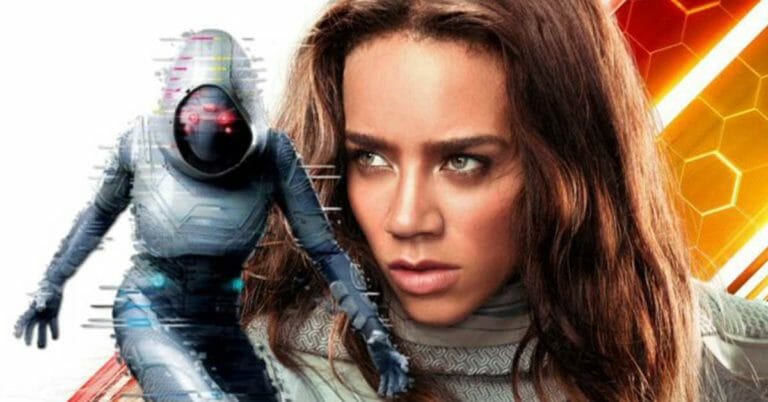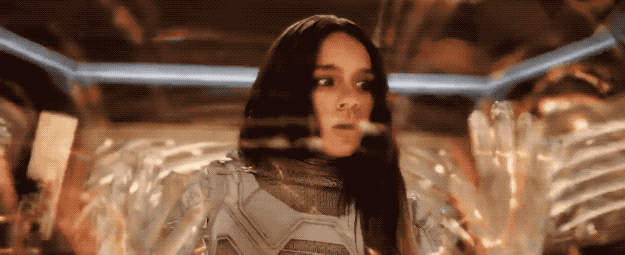By Valerie Kalfrin · July 26, 2018

Ant-Man and the Wasp adds another memorable adversary to Marvel’s gallery with Ghost, a woman who can phase through solid matter and, like a true specter, lingers in audiences’ minds long after the end credits.
Ghost originated in Marvel Comics as a man, a computer programmer and engineer who becomes a vigilante. But director Peyton Reed’s film—credited to a team of five screenwriters, including Paul Rudd, who stars as Scott Lang/Ant-Man—swaps the character’s gender and gifts her with a new backstory born in physical and emotional pain. (Mild spoilers follow.)
Ghost is actually one of several foes in the film pursuing our heroes’ technology—and shrinkable lab—that enables them to tap into the quantum realm. (The plot is like an intricate and entertaining game of keep-away.)
But whereas black-market dealer Sonny Burch (Walton Goggins of TV’s Justified and Tomb Raider) wants the tech to get rich, Ghost, aka Ava Starr (Hannah John-Kamen), wants to heal herself. Injured during an experiment that affected her molecular structure, she needs to wear body armor, sleep in a special chamber, and concentrate to keep from ripping apart.
John-Kamen (TV’s Killjoys and Ready Player One) infuses her performance with such physicality—her stiff walk alone looks like someone trying to hold herself together—that we feel her effort to live with constant pain.
In interviews, John-Kamen says she relished creating such ambivalence and specifically calls her character an antagonist. “I love to look at Ghost as … she is the threat in the movie, a hundred percent, but no, she’s not a villain,” she told The IMDb Show. “She’s desperate. She has a very clear goal in the movie, and I think that’s what Marvel, they do so well. The villainous characters are redeemable, and it’s not black and white.”

Here are three ways that Ghost and other Marvel antagonists challenge the heroes while making an emotional impact on the audience.
A desire for power or money alone can leave an audience feeling empty. But Marvel’s more notable villains have an added layer: We can identify with what drives them, and we understand their motives.
Darren Cross, aka Yellowjacket (Corey Stoll), didn’t want the size-changing technology of 2015’s Ant-Man solely for wealth or nefarious purposes. He was an angry and insecure genius who wanted his mentor, Dr. Hank Pym (Michael Douglas), to acknowledge his smarts.
Loki (Tom Hiddleston), who has caused trouble since 2011’s Thor and 2012’s The Avengers, is the adopted son who can never measure up to his parents’ favorite, Thor (Chris Hemsworth), a demigod who controls lightning.
In Ant-Man and the Wasp, a flashback shows how Ava as a child ran into her father’s lab so he wouldn’t be alone once his experiment went wrong. The resulting explosion killed him and changed her molecular stability, turning her into Ghost.
As an adult, she worked for S.H.I.E.L.D. for a while as an assassin, but she’s a tragic figure. She feels used, and because of her phasing ability, she’s isolated. The qualities that make her so difficult to catch also make it grueling for her to touch someone or something she wants. (Little Ava can barely grasp a teddy bear.)
“[T]here’s no such thing as a villain being a villain,” John-Kamen told Entertainment Tonight. “And actually, in her mind, she’s misunderstood, and everybody else are the bad guys and she’s the good guy.”
We’d hardly say Thanos (Josh Brolin) in this year’s Avengers: Infinity War is redeemable. Wiping out half the living things in the universe is horrific. But he fascinates because of his conviction that he’s doing what’s right and necessary. There simply aren’t enough resources to support everyone, he reasons, so half the universe must be sacrificed. (Clearly, this guy has never heard of recycling. Or alternate sources of energy.)

Some Marvel villains have more than just relatable motives. They’re similar enough to the heroes that they act as a mirror, a teacher with a sobering lesson. They show the hero a line that he or she doesn’t want to cross.
Adrian Toomes, aka Vulture (a brilliant Michael Keaton), in 2017’s Spider-Man: Homecoming is a working-class family man who found a taste for crime after needing a payday. He and Peter Parker/Spider-Man (Tom Holland) recognize in each other someone with ambition and pride who wants respect. But these qualities make Toomes blind to the fact that by feeding his ego—sticking it to golden guys like Tony Stark (Robert Downey Jr.), or so he thinks—he’s endangering the good things in his life, such as his loving family.
The deaths of his family offscreen during the events of 2015’s Avengers: Age of Ultron spur Helmut Zemo (Daniel Brühl) to fracture the team in 2016’s Captain America: Civil War by bringing painful secrets to light. Vengeance motivates him but proves cold comfort, as T’Challa, aka Black Panther (Chadwick Boseman), realizes. T’Challa wants revenge for his father’s slaying for much of that film, until he sees how consuming vengeance can be. “I’m done letting it consume me,” he says.
Erik Killmonger (Michael B. Jordan) in Black Panther’s standalone film earlier this year proves to be an even greater mirror for T’Challa and catalyst for change. The two are cousins, revealed after T’Challa takes the throne of the fictional African nation of Wakanda; but Killmonger grew up in Oakland, Calif., abandoned after T’Challa’s father killed his. T’Challa sees how his country’s isolationism molded Killmonger into a radical who now wants to arm the oppressed. T’Challa doesn’t want his country’s weapons to fall into dangerous hands but decides that Wakanda has a greater responsibility to the world. Its inventions and technology can educate others and treat illnesses.

The Marvel films at this point work like well-oiled machines, but as the franchise has grown, so have the antagonists. They don’t pursue phenomenal power for power’s sake, as Red Skull (Hugo Weaving) did in 2011’s Captain America: The First Avenger—although he also was in league with the Nazis. Instead, they have a goal that’s achievable within the world of the film.
Thanos’s plan has the grandest scale, but considering the powers he wields through the Infinity Gauntlet—and the number of heroes trying to stop him—it needs to be.
By contrast, Ghost wants the lab so she can access quantum-realm energy to stabilize herself. Her chasing after it interferes with the plans of Dr. Pym, Scott, and the Wasp/Hope van Dyne (Evangeline Lilly) to rescue Hope’s mother, Janet (Michelle Pfeiffer), who has been lost in the quantum realm for decades.
Likewise, the heist in the original Ant-Man film is on a small but clever scale—stealing Dr. Pym’s creations back from Cross, who’s in league with terrorists, and safeguarding his research.
They’re not out to “take over the world,” which is too amorphous a goal, but they clearly create problems for our heroes. Keeping the story’s scale in mind, even if your characters don’t change size, can lead to more personal stakes and a satisfying resolution.

As Tim Grierson noted in MEL Magazine, Ant-Man and the Wasp is such a “modest charmer” because it’s heartfelt and touching, and “the audience’s concerns aren’t ‘Oh, man, is Earth gonna be wrecked?’ but rather, ‘I sure hope these characters I like get their happy ending.’ It’s refreshing to watch a superhero movie where that’s all that’s on the line.”
 Valerie Kalfrin is an award-winning crime journalist who now dives into fictional mayhem as an author (Quicklet on The Closer: Season 1), essayist, film critic, screenwriter, and emerging script consultant. She also writes for The Guardian, Bright Wall Dark Room, ScreenCraft, Hazlitt, Signature, and the blog for Final Draft, the top-rated screenwriting software used by the filmmaking industry. A member of Screenwriters of Tomorrow, she’s collaborated on short films and features, and she’s affiliated with the Tampa Bay Film Society. She lives in Florida. Find her online at valeriekalfrin.com.
Valerie Kalfrin is an award-winning crime journalist who now dives into fictional mayhem as an author (Quicklet on The Closer: Season 1), essayist, film critic, screenwriter, and emerging script consultant. She also writes for The Guardian, Bright Wall Dark Room, ScreenCraft, Hazlitt, Signature, and the blog for Final Draft, the top-rated screenwriting software used by the filmmaking industry. A member of Screenwriters of Tomorrow, she’s collaborated on short films and features, and she’s affiliated with the Tampa Bay Film Society. She lives in Florida. Find her online at valeriekalfrin.com.
Photo credit: Superfans and Marvel
For all the latest from The Script Lab, be sure to follow us on Twitter, Facebook, and Instagram.